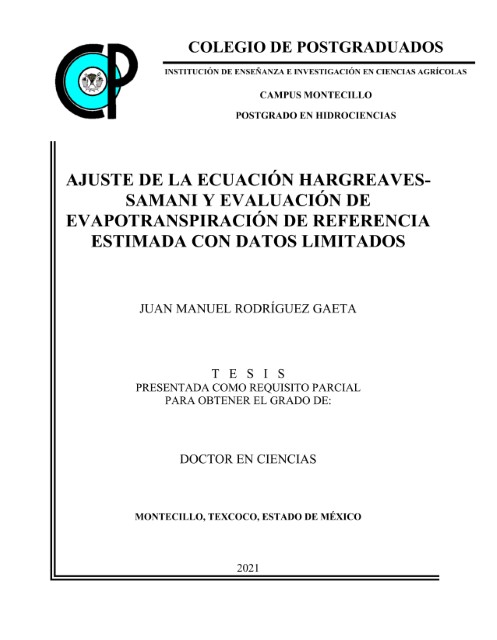
Juan Manuel Rodríguez Gaeta, Dr. Colegio de Postgraduados, 2021
RESUMEN
La creciente demanda de alimentos y cultivos comerciales
exige la expansión continua de tierras de sembradío, por lo que se puede generar
una gran tensión en los recursos hídricos en gran parte del mundo. México cuenta
aproximadamente con un 50% de su territorio con diferentes niveles de estrés
hídrico, principalmente al norte de su territorio. El estado de Chihuahua
situado dentro de estas condiciones, presenta problemas de escasez y
sobreexplotación de agua, por lo que se ha vuelto una necesidad cuantificar las
pérdidas de agua en las zonas de producción agrícola. Estimar la
evapotranspiración de referencia (ET0) es uno de los enfoques para cuantificar
la demanda evaporativa de la atmósfera sobre los cultivos, siendo el método de
referencia el desarrollado por Penman-Montieth (P-M), descrito en el manual 56
de la Organización de las Naciones Unidas para la Agricultura y la Alimentación
(FAO), el cual se basa en cuatro variables meteorológicas principales: radiación
neta, presión de vapor, velocidad del viento y temperatura del aire; sin
embargo, la escasa disponibilidad de datos limita el uso de este método en
muchas regiones. Por ello, el objetivo de esta investigación fue evaluar y
ajustar a condiciones locales el coeficiente kg de la ecuación de radiación
solar (Rs), integrada en la ecuación original de Hargreaves (HG), y el
coeficiente de Hargreaves (CHG) de la ecuación de Hargreaves y Samani (HG-S)
(primera parte), así como el modelo de datos faltantes de P-M (segunda parte).
La comparación por pares se realizó por medio de la raíz del error cuadrado
medio (RMSE), el error medio absoluto (MAE), error de sesgo medio (MBE), el
porcentaje de error (PE) y el coeficiente de determinación (R2). La primera
parte del estudio se realizó con datos diarios de las agro- estaciones: Aldama,
Sacramento, Camargo y Jiménez. Se consideraron intervalos diarios, mensuales y
tres periodos definidos por las condiciones climáticas para el ajuste de los
coeficientes. En la evaluación, las estaciones Camargo y Jiménez alcanzaron
errores (PE) superiores al 20%. El coeficiente kg ajustado fue menor a 0.16 en
las cuatro estaciones, mejorando solo la ET0 de HG con PE< 3% en la estación
Jiménez. Los ajustes mensuales y por periodos del CHG, en general brindaron
buenos resultados. No obstante, se recomiendan los ajustes mensuales para zonas
que presentan U2>2 m s-1. Para la segunda parte, se agregaron cuatro estaciones
más: Rosales, Nuevo Casas Grandes, Janos y estación Samalayuca. La estimación de
la humedad relativa (PM-HR) y la aplicación del promedio global de la velocidad
del viento (2 m s-1) (PM-U2) generaron resultados interesantes de acuerdo a las
condiciones climáticas en donde se evaluaron. Los resultados dejan ver el
impacto de cada variable sobre la ET0 en cada zona, y así fortalecer los
criterios sobre la selección adecuada del método a aplicar.
Palabras clave: Chihuahua, recursos hídricos, variables meteorológicas.
ADJUSTMENT OF THE HARGREAVES-SAMANI EQUATION AND EVALUATION OF ESTIMATED REFERENCE EVAPOTRANSPIRATION WITH LIMITED DATA
Juan Manuel Rodríguez Gaeta, Dr. Colegio de Postgraduados, 2021
ABSTRACT
The growing demand for food and cash crops requires the continued expansion of farmland, which can put a strain on water resources in much of the world. Mexico has approximately 50% of its territory with different levels of water stress, in the north of its territory. The state of Chihuahua, located within these conditions, presents problems of water scarcity and overexploitation, so it has become a necessity to quantify water losses in agricultural production areas. Reference evapotranspiration (ET0) is one of the approaches to quantify water losses by the evaporative demand of the atmosphere, applying the Penman-Montieth (P-M) model, described in the manual 56 of the Food and Agriculture Organization of the United Nations (FAO), based on four main meteorological variables: net radiation, vapor pressure, wind speed and air temperature. However, the scarce availability of data limits the use of this method in many regions, so the objective of this research was to evaluate and adjust to local conditions the kg coefficient of the solar radiation (Rs) equation, integrated into the original Hargreaves equation (HG) and the Hargreaves coefficient (CHG) of the Hargreaves-Samani equation (HG-S) (1st part), as well as the missing data model of P-M (2nd part). The pairwise comparison was made by means of the root mean square error (RMSE), mean absolute error (MAE), mean bias error (MBE), percent error (PE) and coefficient of determination (R ). The first part of the study was carried out with daily data from the agro-stations: Aldama, Sacramento, Camargo and Jimenez. Daily, monthly and three periods defined by the climatic conditions were considered for the adjustment of the coefficients. In the evaluation, the Camargo and Jimenez stations, reached errors (PE) higher than 20%. The adjusted kg coefficient was less than 0.16 in the four stations, improving only the ET0 of HG with PE< 3% in Jimenez station. The monthly and periodical adjustments of the CHG, in general provided good results. However, monthly adjustments are recommended for areas with U2>2 m s 2 . For the 2nd part, four more stations were added: Rosales, Nuevo Casas Grandes, Janos and Samalayuca station. The estimation of relative humidity (PM-HR) and the application of the global average wind speed (2 m s -1 ) (PMU2) generated interesting results according to the climatic conditions where they were evaluated. The results show the impact of each variable on the ET0 in each area, and thus strengthen the criteria on the appropriate selection of the method to be applied.
Keywords: Chihuahua, water resources, meteorological variables. .
Fecha: 2021-01
Estudiante: Juan Manuel Rodríguez Gaeta
DOCTORADO EN CIENCIAS - HIDROCIENCIAS
Consejo Particular:
Consejera: Dra. Antonia Macedo Cruz
Asesor: Dr. Carlos Ramírez Ayala
Asesor: Dr. Martín Alejandro Bolaños González
Asesor: Dr. Rafael Ángel Parra Quezada